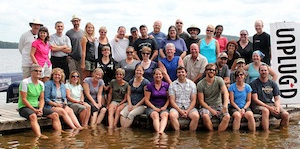 We launched our PLP group blog Voices from the Learning Revolution just six months ago, and we’ve now shared 65 wide-ranging posts about the future of learning, written by teachers, librarians, IT specialists, principals, district leaders and consultants who are allied with our Powerful Learning Practice communities.
We launched our PLP group blog Voices from the Learning Revolution just six months ago, and we’ve now shared 65 wide-ranging posts about the future of learning, written by teachers, librarians, IT specialists, principals, district leaders and consultants who are allied with our Powerful Learning Practice communities.
Back in May, we summarized the first 30 essays and articles in a summary post you can browse here. Now we’re back with our second collection of great reads.
Once again, our special thanks to KQED’s MindShift blog and The Washington Post Answer Sheet for reprinting selections from our VFLR collection. And thanks to all the edubloggers and tweeters in our PLP communities and PLNs who help push these ideas and insights about innovative learning into the global knowledge stream.
Browse all of our posts:
Easy Reference Index: Voices Posts (1-29)
Easy Reference Index: Voices Posts (30-65)
Easy Reference Index: Voices Posts (66-92)
 65. From the Canadian UnPlug’d Conference: ‘Why Social Justice in Education Matters’
65. From the Canadian UnPlug’d Conference: ‘Why Social Justice in Education Matters’
“I recently convened for three days with 37 educators who are passionate about education,” writes Saskatchewan high school teacher Shelley Wright. “We forfeited technology for the company of fellow teachers, consultants, administrators, university professors and school trustees. No cell phone reception. No Internet connection. Unplug’d.” Read more
64. Bud Hunt: Thoughts for New Teachers
“Try very hard not to work all the time,” Bud the Teacher advises newbies. “You CAN be that hero teacher that everyone loves and is in awe of, but only for a little while. Then, you burn out and fade away and don’t do anyone any good at all.” Read more
63. Out with Professional Development – in with Professional Learning.
In their revised national standards, says principal Lyn Hilt, the Learning Forward organization has undergone an important shift in focus and message, “from one of professional development to one of professional learning.” The new standards focus on teachers as learners with individual needs and interests, “not vehicles through which schools deliver programs and policies.” Read more
62. My First Year of Teaching Dangerously
“Our kids are beginning to hate school,” writes Becky Bair, an upper elementary teacher in Pennsylvania’s Elizabethtown School District. “It was time for me to change my teaching, no matter how scary the prospect might be.” It was terrifying at first, she says, but in the end the results caused her to “jump up and cheer.” Read more
61. Tools, Not Toys — Becoming a Techy Teacher
“At some point this past school year, I began to truly understand how to change my teaching,” explains elementary teacher Patti Grayson. The big revelation: It’s NOT about technology. “Just using the equipment — or the web tools it allows us to access – isn’t going to lead us or our students to truly connected learning.” Read more
60. Want Innovation? Put Teachers & Students in Charge of Learning
“If we give teachers the responsibility, the time and most importantly the autonomy to design, implement, evaluate, tweak and improve their pedagogy and curriculum, that is when we will really see innovation happen,” says 30-year veteran and Web 2.0 leader Brian Crosby. Read more
59. Dear American Friends: I Love Your ISTE!
“There is one great difference between Norwegian/Swedish educators and those in North America,” writes Norway teacher leader Ann Michaelsen. It’s “the willingness to commit time to personal development outside the normal business/school hours.” Michaelsen loved the hunger to learn she witnessed at the Philadelphia ISTE conference this past June. Read more
58. Inside My Global Classroom
“I’m an Australian,” says teacher/librarian Jenny Luca, “and yet I function in online networks with educators from all parts of the world. I know my practice has benefited from these interactions. Some of the most exciting times I’ve experienced with students have come when we’ve made contact with a teacher or class in another country.” Luca includes great ideas about building your own global classroom. Read more
 57. Twitter for Teachers: Discover #hashtag PD
57. Twitter for Teachers: Discover #hashtag PD
VFLR blogger Patti Grayson has gone from Twitter novice to accomplished Twitter user in a year’s time. The big jump came earlier this summer, when she plumbed the depths of hashtagging and discovered the micro-blogging tool’s secret capacity to form meaningful professional communities — 140 characters at a time. Read more
56. Teens & Learning: The 30-minutes Question
Can teenagers actually point to some place in the day that they recall learning something? Texas IT leader Holt asked his high school son, “What 30 minutes stands out most in your day?” Response: “Lunch, because I got to be with my friends.” It’s clear to Holt that “our lessons and curriculum need to be more social in nature” — and social media can help. Read more
55. The Flip: Why I Love it – How I Use It
High school teacher Shelley Wright is adding the flipped classroom strategy to her toolbox. “I believe if used judiciously, in the right context, the flip can free up valuable class time and provide the background knowledge that is fundamental for students to then go forward and wrestle with higher order thinking.” Read more
54. 21st Century High: The Shift Begins
Ed Allen, an assistant principal at Cardinal O’Hara High near Philadelphia, writes: “Our netbooks pilot is teaching us something both about the challenges of 1-to-1 implementation and the powerful learning that can occur when classrooms become connected.” (Includes video with student comments) Read more
53. Turning Tweets into Narrative Tales
Ever wish Twitter provided a more coherent narrative? Middle grades teacher Marsha Ratzel offers a tale of science adventure that underscores the value of Personal Learning Networks and the power of Storify, a web tool that “helps you assemble disparate tweets, pictures, retweets, responses to tweets and direct messages into one place and a single storyline.” Read more
52. Blended Learning Helps Us Mind the Gaps
“I like Khan Academy,” writes independent school teacher librarian Renee Hawkins. “Students can move at their own pace and practice until they understand the concept. In other words, students can own their learning.” She wonders: “How many academic stars do we lose now because they don’t progress at the rate considered necessary by unit and test calendars?” Read more
51. All Principals Should Be Tech Savvy
Is it necessary for an administrator to become proficient in using a variety of technologies and understand how web tools augment instruction? Increasingly the answer is yes, says elementary principal Lyn Hilt. School leaders must becomet truly tech-savvy. Read more
50. Igniting the Heart of Learning in the Collaborative Age
Connectivity empowers students to learn in unprecedented ways, writes Catholic educator Sister Geralyn Schmidt. “But, to quote a comic book superhero, ‘with great power comes great responsibility.’ We have a duty as educators to instruct our students to a higher good, not just the good for me.” Read more
 49. Must We Shrink Wrap Our School Libraries?
49. Must We Shrink Wrap Our School Libraries?
Ohio’s budget woes recently forced her school system to pink-slip 61 educators, including 10 library staff, writes district leader M.E. Steele-Pierce. While some districts chose to close libraries and shrink wrap collections, “We won’t do that. What we are doing is talking with designers, leaders, and librarians with experience and vision. We’re asking lots of questions, seeking models that do not replicate the stacks of the past.” Read more
48. Confessions of a Closet Constructivist
Most of our current classrooms structurally discourage cooperation and collaboration, says high school teacher Shelley Wright. “For many hours of the day, our students are expected to sit and learn by themselves. I have to confess that all of the years I’ve taught, my classroom has been teacher-centered. Next year it will be different.” Read more
47. How We’re Cultivating Inventive Thinkers in the Middle Grades
Chris Preston shares three unifying concepts identified by his middle school teacher team during a year of action research on inventive thinking. The learning experience must be (1) authentic, (2) connected, and (3) collaborative. “At the conclusion of our instruction,” he says, “many students said they would approach solutions to questions much differently in the future.” Read more
46. Constructing History in Our High School Project-Based Classroom
“This past school year,” writes history teacher Margaret Haviland, “our exploration of World War I was designed to enable students to construct their own knowledge and their own meaning within a framework established by myself and my intern.” Haviland documents a remarkable journey toward deeper learning in this post. Read more
45. Passionate School Reform
“We are not teaching our students to pursue passions,” says Tim Holt, an tech educator in El Paso TX. “Instead, we are teaching students to pursue predetermined pathways that they may or may not value. Too often, they leave their passions at the doorway of education and career, and maybe pick them back up when they leave the building.” Read more
44. Learning Like a Hurricane
Middle grades science/math teacher Marsha Ratzel spent some of her summer “on my back porch thinking about my teaching over the past year…what I did well and where I could improve.” One goal for 2011-12: Create “a sharp, logically designed, power-packed unit to start off the year. I want to set the bar high and give my students room to find out what they’re made of.” Read more
 43. Global Connections: My PLN Story
43. Global Connections: My PLN Story
Norwegian educator Ann Michaelsen writes: “The interactions my students had with award-winning African educator Moliehi Sekese would not have been possible without my ability to connect through Facebook, Twitter, Skype and Blogs.” These social media tools give teachers and students the power to create personal learning networks “on a global scale.” Read more
42. VOICES Interview: Larry Ferlazzo’s top picks for 21stC teaching and learning
VFLR editor John Norton interviews teaching resources guru Larry Ferlazzo, famous for the 100s of “Best” lists at his blog Websites of the Day. Norton’s goal was “to pick Larry’s brain and garner some of his best of the best.” Read more
41. My Year of Teaching Loopily
This fall Patti Grayson will “loop” by following her 3rd grade students into 4th grade. She’s excited about the opportunity. She already knows this group of kids well — their reading levels, learning styles, strengths and weaknesses. And they know her classroom rules and expectations. “We’ll be able to leap right into the heart of learning.” Read more
40. How Teacher Librarians Can Save the World (and maybe their jobs)
As schools around the country pink-slipped librarians because of budget cuts, district leader M.E. Steele Pierce “began my own ninja quest to better understand the shift from library-as-sacred-institution to library-on-the-chopping-block.” Who are the library change agents championing alternatives to the old school library model? She turned for answers to Gwyneth Jones, The Daring Librarian. Read more
39. This summer, I won’t be learning how to be a better teacher
During summer 2011, wrote teacher Shelley Wright, “I don’t plan to vacate or take a course that in the end would probably leave me tired and weary. Instead, I plan to spend the summer in artful restoration, through passionate, fun, deep learning. I won’t be learning how to be a better teacher. Those days are over. In reality, it’s not what my students need.” Read more
38. Jump into 21st C Learning this summer!
For Sister Geralyn Schmidt, summer is a time for rest, relaxation and deeper reflection on teaching practice. If you’ve been saying to yourself: “I’ve read a lot about 21st century learning, but how do I incorporate the latest and greatest into my teaching?” — the good Sister is here with some ideas that might encourage you to jump right in! Read more
37. Evolution of an Information Junkie
“People are often incredulous,” writes teacher librarian Jenny Luca, “at how many browser tabs I have open at any one time. It’s of no consequence to me; I know what’s there and why I have them open. This is how I live now. In fact, it’s apparent to me that this is just part of my natural evolutionary process.” Read more
36. Three Big Ideas from Leadership Boot Camp
“It’s been three years since my professional life changed and it’s hard to recall where I was in my thinking at that time,” writes virtual school leader Tony Baldasaro. “Or maybe it’s because life now is so much more fulfilling that I don’t reflect enough on the journey that brought me to the here and now. If that’s the case, it’s time to do so.” Read more
35. Will My 3rd Graders Be ‘Educated’ When They Grow Up?
“If we concentrate on fostering curiosity and exploration in the early grades,”opines elementary teacher Patti Grayson, “and guide students to find joy in learning and discovery through their passions and interests, then as those interests change (and the world changes) they will possess the tools and insight to continue to seek learning opportunities.” Read more
“After being a little bit mistreated by some folks who don’t understand civil dialogue,” writes Bud Hunt, US Department of Education Press Secretary Justin Hamilton asked educators to share “what they’re for, education policy-wise, not just what they’re against. That seemed like a reasonable request. Here’s my list.” Read more
33. The Power of the Connected Classroom: Why & How I’m Teaching Social Justice
“This is one of the most important weeks of English 10B,” reports Shelley Wright. “We begin to delve into a gamut of complicated, yet crucial human rights issues. From what I’ve seen of this generation, this is the ‘stuff’ that matters. I teach to show my students that the bystander effect is lethal, often on a scale beyond our imagination.” Read more
32. #edpolicy: What’s missing in the conversation
In the current policy conversations, asks author and retired educator Lani Ritter Hall, “where are students? Where is pedagogy? Where is technology? What has happened to a careful, deep exploration of the complexities inherent in teaching for student learning? Where is understanding deeply how people learn?” Read more
31. Our New Classroom Challenge – the Vessay
High school students in Shelley Wright’s classes are preparing “vessays” — persuasive essays produced via the VoiceThread online software. “It will require a thesis that can be argued, transition words to make their writing fluid, and evidence from the text to support their point.” Plus images. Plus voice. “For many of my students, this will be difficult. Forging into new territory can be hard work for all of us.” Read more
30. PLP Journey: Planning Our EdCamp PD Day
“Our faculty,” explains science teacher Delores Gende, “has been very active throughout the year implementing innovative teaching strategies and creating engaging projects that fit their Individual Plan for 21st Century Teaching and Learning professional goals. These goals are not mandated by the administration but selected by each teacher. So why not apply this same PD approach to designing our Professional Learning Day?” Read more
Follow our Voices in the coming weeks and months by subscribing here!
John Norton
Latest posts by John Norton (see all)
- I'm a "Learner First" in a Whole New World - July 1, 2013
- Hale@home: Easing Student Transitions via Online Learning - May 17, 2013
- Our Top 13 Voices Posts for 2012! - January 1, 2013


